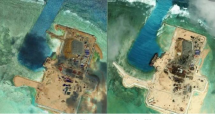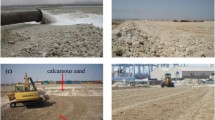Abstract
The behaviour of a granular material is primarily affected by its particle size distribution (PSD), which is not necessarily a soil constant as assumed in traditional soil mechanics. The PSD may change over time due to mechanical as well as environmental actions. In this study, a series of ring shear tests and one-dimensional compression tests were completed on carbonate sand, in both dry and saturated conditions. Samples were prepared with different initial uniform gradings, to investigate: (1) the influence of the saturation state and initial grading on mechanical and deformational behaviour of carbonate sands and (2) the evolution of the PSD as a result of breakage. The ring shear tests show that the residual friction angle remains almost constant, but dilatancy reduces with increasing saturation degree. In the one-dimensional compression test, the yield stress decreases with increasing saturation degree, but the compressibility (as defined by Cc) remains almost constant, irrespective of the saturation state. Moreover, saturated samples suffer more breakage than dry samples during ring shear tests, while there is no obvious effect of saturation state on particle breakage in one-dimensional compression. A recently proposed PSD model with only two parameters (λp and κp) is employed to model the evolution of PSD, as it can more broadly capture the whole PSD throughout the breakage process than existing breakage indices. Test results demonstrate that parameter λp is linearly related to Einav’s breakage index \( B_{\text{r}}^{*} \) and is dependent on initial grading, but independent of test mode. Parameter κp is in power relationship with \( B_{\text{r}}^{*} \) and is independent of initial grading or test mode. The evolution of parameters λp and κp is related to the input work for both ring shear and compression tests, with λp being hyperbolically related to input work and κp in power relationship with input work. Using such an evolution law provides an alternative approach to capture the effects of particle breakage in constitutive models.

















Similar content being viewed by others
Abbreviations
- PSD:
-
Particle size distribution
- γ :
-
Shear strain
- ε v :
-
Vertical strain
- h :
-
Sample height
- δS and δv :
-
Variation in shear and vertical displacement
- C c :
-
Compression index
- \( \sigma_{\text{v}}^{\prime } \) and \( \sigma_{\text{vy}}^{\prime } \) :
-
Effective vertical stress and yield stress
- d 50 :
-
Particle size at 50% finer of size distribution curve
- d 63.2 :
-
Particle size at 63.2% finer of size distribution curve
- P :
-
Percentage finer
- d, dmax and dmin :
-
Particle size, the maximum particle size and the minimum particle size
- D :
-
Fractal dimension
- τn/σv :
-
Normalised shear stress
- ψ max :
-
The maximum rate of dilation
- ϕpeak and ϕresidual :
-
Peak mobilised friction angle and mobilised residual friction angle
- \( B_{\text{r}}^{*} \) :
-
Einav’s breakage index [14]
- λp and κp :
-
PSD indices
- λinitial and λultimate :
-
PSD index at initial state and PSD index at ultimate state
- R D :
-
Ratio of maximum to minimum particle size
- α λ :
-
Parameter related to initial PSD
- W V :
-
Total input work per unit volume
- αW and WVR :
-
Parameters related to λp
- a and b :
-
Parameters related to κp
References
Altuhafi FN, Coop MR (2011) The effect of mode of loading on particle-scale damage. Soils Found 51(5):849–856
Altuhafi FN, Coop MR, Georgiannou VN (2016) Effect of particle shape on the mechanical behavior of natural sands. J Geotech Geoenviron Eng 142(12):04016071
Angemeer J, Carlson E, Klick JH (1973) Techniques and results of offshore pile load testing in calcareous soils. In: 5th offshore technology conference, Houston, Texas, pp 677–692
Becker DE, Crooks JHA, Been K, Jefferies MG (1987) Work as a criterion for determining in situ and yield stresses in clays. Can Geotech J 24(4):549–564
Bolton MD (1986) Strength and dilatancy of sands. Géotechnique 36(1):65–78
Bolton MD, Nakata Y, Cheng YP (2008) Micro-and macro-mechanical behaviour of DEM crushable materials. Géotechnique 58(6):471–480
Bromhead EN (1979) A simple ring shear apparatus. Ground Eng 12(5):40, 42, 44
British Standards Institution (BSI) (1990) BS1377: British standard methods of test for soils for civil engineering purposes. Part 7: Shear strength tests (total stress)
Cho GC, Dodds J, Santamarina JC (2006) Particle shape effects on packing density, stiffness and strength: natural and crushed sands. J Geotech Geoenviron Eng 132(5):591–602
Cheng YP, Nakata Y, Bolton MD (2003) Discrete element simulation of crushable soil. Géotechnique 53(7):633–641
Ciantia MO, Arroyo M, O’Sullivan C, Gens A (2019) Micromechanical inspection of incremental behaviour of crushable soils. Acta Geotech. https://doi.org/10.1007/s11440-019-00802-0
Coop MR, Sorensen KK, Freitas TB, Georgoutsos G (2004) Particle breakage during shearing of a carbonate sand. Géotechnique 54(3):157–164
Daouadji A, Hicher PY, Rahma A (2001) An elastoplastic model for granular materials taking into account grain breakage. Eur J Mech A Solids 20(1):113–137
Einav I (2007) Breakage mechanics—part I: theory. J Mech Phys Solids 55(6):1274–1297
Ezaoui A, Lecompte T, Di Benedetto H, Garcia E (2011) Effects of various loading stress paths on the stress–strain properties and on crushability of an industrial soft granular material. Granul Matter 13(4):283–301
Ham TG, Nakata Y, Orense R, Hyodo M (2009) Influence of water on the compression behavior of decomposed granite soil. J Geotech Geoenviron Eng 136(5):697–705
Hardin BO (1985) Crushing of soil particles. J Geotech Eng 111(10):1177–1192
Hu W, Yin ZY, Scaringi G, Dano C, Hicher PY (2018) Relating fragmentation, plastic work and critical state in crushable rock clasts. Eng Geol 246:326–336
Hyodo M, Wu Y, Aramaki N, Nakata Y (2016) Undrained monotonic and cyclic shear response and particle crushing of silica sand at low and high pressures. Can Geotech J 54(2):207–218
Indraratna B, Sun Y, Nimbalkar S (2016) Laboratory assessment of the role of particle size distribution on the deformation and degradation of ballast under cyclic loading. J Geotech Geoenviron Eng 142(7):04016016
Kelly RB, Airey DW (2005) A large diameter ring shear apparatus and the effects of long distance shearing on interface friction angles and grain crushing. Aust Geomech 40(2):65–74
Konrad J-M, Salami Y (2018) Particle breakage in granular materials—a conceptual framework. Can Geotech J 55(5):710–719
Lade PV, Yamamuro JA, Bopp PA (1996) Significance of particle crushing in granular materials. J Geotech Eng 122(4):309–316
Lee KL, Farhoomand I (1967) Compressibility and crushing of granular soil in anisotropic triaxial compression. Can Geotech J 4(1):68–86
Lee KL, Seed HB (1967) Drained strength characteristics of sands. J Soil Mech Found Div 93(6):117–141
Li G, Liu YJ, Dano C, Hicher PY (2014) Grading-dependent behavior of granular materials: from discrete to continuous modeling. J Eng Mech 141(6):04014172
Li M, Zhang J, Zhou N, Huang Y (2017) Effect of particle size on the energy evolution of crushed waste rock in coal mines. Rock Mech Rock Eng 50(5):1347–1354
Luzzani L, Coop MR (2002) On the relationship between particle breakage and the critical state of sands. Soils Found 42(2):71–82
McDowell GR (2002) On the yielding and plastic compression of sand. Soils Found 42(1):139–145
Miao G, Airey D (2013) Breakage and ultimate states for a carbonate sand. Géotechnique 63(14):1221–1229
Miura N, Yamanouchi T (1975) Effect of water on the behavior of a quartz-rich sand under high stresses. Soils Found 15(4):23–34
Miura N, O’Hara S (1979) Particle-crushing of a decomposed granite soil under shear stresses. Soils Found 19(3):1–14
Nakata Y, Hyde AFL, Hyodo M, Murata H (1999) A probabilistic approach to sand particle crushing in the triaxial test. Géotechnique 49(5):567–583
Nakata Y, Hyodo M, Hyde AF, Kato Y, Murata H (2001) Microscopic particle crushing of sand subjected to high pressure one-dimensional compression. Soils Found 41(1):69–82
Nanda S, Sivakumar V, Donohue S et al (2018) Small strain behavior and crushability of Ballyconnelly carbonate sand under monotonic and cyclic loading. Can Geotech J 55(7):979–987
Oldecop LA, Alonso EE (2007) Theoretical investigation of the time-dependent behaviour of rockfill. Géotechnique 57(3):289–301
Ovalle C, Dano C, Hicher PY, Cisternas M (2014) Experimental framework for evaluating the mechanical behavior of dry and wet crushable granular materials based on the particle breakage ratio. Can Geotech J 52(5):587–598
Ovalle C (2018) Role of particle breakage in primary and secondary compression of wet and dry sand. Géotech Lett 8:161–164
Poulos HG (1980) A review of the behaviour and engineering properties of carbonate soils. University of Sydney Research Report No. R381
Sadrekarimi A, Olson SM (2010) Particle damage observed in ring shear tests on sands. Can Geotech J 47(5):497–515
Shahnazari H, Rezvani R (2013) Effective parameters for the particle breakage of calcareous sands: an experimental study. Eng Geol 159:98–105
Tong CX, Burton GJ, Zhang S, Sheng D (2018) A simple particle-size distribution model for granular materials. Can Geotech J 55(2):246–257
Tong CX, Zhang KF, Zhang S, Sheng D (2019) A stochastic particle breakage model for granular soils subjected to one-dimensional compression with emphasis on the evolution of coordination number. Comput Geotech 112:72–80
Wang P, Arson C (2018) Energy distribution during the quasi-static confined comminution of granular materials. Acta Geotech 13(5):1075–1083
Wei H, Zhao T, He J, Meng Q, Wang X (2018) Evolution of particle breakage for calcareous sands during ring shear tests. Int J Geomech 18(2):04017153
Xiao Y, Liu H, Xiao P, Xiang J (2016) Fractal crushing of carbonate sands under impact loading. Géotech Lett 6(3):199–204
Xiao Y, Liu H (2016) Elastoplastic constitutive model for rockfill materials considering particle breakage. Int J Geomech 17(1):04016041
Xiao Y, Liu H, Chen Q, Ma Q, Xiang Y, Zheng Y (2017) Particle breakage and deformation of carbonate sands with wide range of densities during compression loading process. Acta Geotech 12(5):1177–1184
Xiao Y, Liu H (2017) Elastoplastic constitutive model for rockfill materials considering particle breakage. Int J Geomech 17(1):04016041
Xiao Y, Long L, Matthew Evans T, Zhou H, Liu H, Stuedlein AW (2018) Effect of particle shape on stress–dilatancy responses of medium-dense sands. J Geotech Geoenviron Eng 145(2):04018105
Xiao Y, Meng M, Daouadji A, Chen Q, Wu Z, Jiang X (2019) Effects of particle size on crushing and deformation behaviors of rockfill materials. Geosci Front. https://doi.org/10.1016/j.gsf.2018.10.010
Xiao Y, Yuan Z, Lin J, Ran J, Dai B, Chu J, Liu H (2019) Effect of particle shape of glass beads on the strength and deformation of cemented sands. Acta Geotech. https://doi.org/10.1007/s11440-019-00830-w
Xiao Y, Yuan Z, Chu J, Liu H, Huang J, Luo SN, Wang S, Lin J (2019) Particle breakage and energy dissipation of carbonate sands under quasi-static and dynamic compression. Acta Geotech. https://doi.org/10.1007/s11440-019-00790-1
Yan WM, Dong J (2011) Effect of particle grading on the response of an idealized granular assemblage. Int J Geomech 11(4):276–285
Yan WM, Shi Y (2014) Evolution of grain grading and characteristics in repeatedly reconstituted assemblages subject to one-dimensional compression. Géotech Lett 4(3):223–229
Zhang S, Tong CX, Li X, Sheng D (2015) A new method for studying the evolution of particle breakage. Géotechnique 65(11):911–922
Zhao B, Wang J, Andò E, Viggiani G, Coop MR (2019) An investigation of particle breakage under one-dimensional compression of sand using X-ray micro-tomography. Can Geotech J. https://doi.org/10.1139/cgj-2018-0548
Acknowledgements
This research was supported by the National Basic Research Program of China (No. 2014CB047001) and the National Natural Science Foundation of China (Grant No. 51722812). The first author would like to acknowledge the support of the China Scholarship Council (201606370041).
Author information
Authors and Affiliations
Corresponding author
Additional information
Publisher's Note
Springer Nature remains neutral with regard to jurisdictional claims in published maps and institutional affiliations.
Chen-Xi Tong: Formerly at Centre of Excellence for Geotechnical Science and Engineering, The University of Newcastle, Callaghan, NSW 2308, Australia.
Rights and permissions
About this article
Cite this article
Tong, CX., Burton, G.J., Zhang, S. et al. Particle breakage of uniformly graded carbonate sands in dry/wet condition subjected to compression/shear tests. Acta Geotech. 15, 2379–2394 (2020). https://doi.org/10.1007/s11440-020-00931-x
Received:
Accepted:
Published:
Issue Date:
DOI: https://doi.org/10.1007/s11440-020-00931-x




